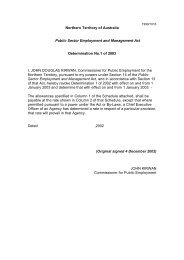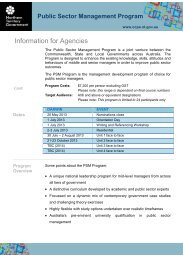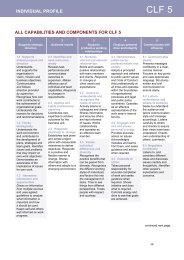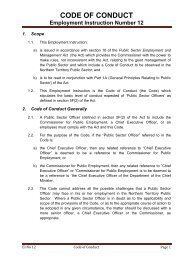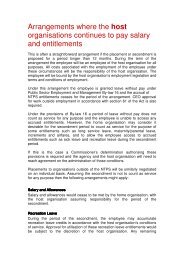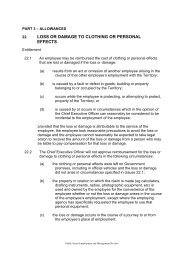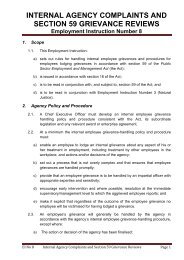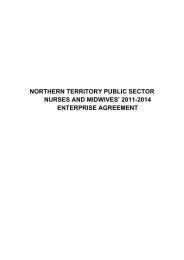Making Workforce Planning Work in the NT Public Sector
Making Workforce Planning Work in the NT Public Sector
Making Workforce Planning Work in the NT Public Sector
Create successful ePaper yourself
Turn your PDF publications into a flip-book with our unique Google optimized e-Paper software.
Contents4 Introduction5 Why is workforce plann<strong>in</strong>g important<strong>in</strong> <strong>the</strong> Nor<strong>the</strong>rn Territory <strong>Public</strong> <strong>Sector</strong>?7 What is workforce plann<strong>in</strong>g?8 What is workforce development?9 Concepts you need to be clear about before you start plann<strong>in</strong>g11 A few important th<strong>in</strong>gs to remember!14 How do you do workforce plann<strong>in</strong>g – gett<strong>in</strong>g started28 A workforce plann<strong>in</strong>g chart30 The language of workforce plann<strong>in</strong>g40 L<strong>in</strong>ks to <strong>the</strong> sample Supply Gap Calculation Tool41 Useful references
• consistency <strong>in</strong> report<strong>in</strong>g format• coord<strong>in</strong>ated workforce development strategies• agency and sector-wide monitor<strong>in</strong>g of outcomes• a commitment to streng<strong>the</strong>n regional workforce development <strong>in</strong>itiatives.The Nor<strong>the</strong>rn Territory Government Framework for <strong><strong>Work</strong>force</strong> <strong>Plann<strong>in</strong>g</strong> isa generic document which is consistent with <strong>the</strong> Standards Australia 2008<strong><strong>Work</strong>force</strong> <strong>Plann<strong>in</strong>g</strong> Guidel<strong>in</strong>es.The framework enables:a) sector wide evidence based workforce plann<strong>in</strong>gb) agency autonomy.This assists agencies <strong>in</strong> <strong>the</strong> identification of and accountability for workforcedevelopment strategies. The process and methods outl<strong>in</strong>ed <strong>in</strong> this frameworkare transferrable to any agency environment.All agencies need to position <strong>the</strong>mselves to reta<strong>in</strong> and attract <strong>the</strong> talent<strong>the</strong>y require now and <strong>in</strong> <strong>the</strong> future. This can be achieved through evidencebased workforce plann<strong>in</strong>g, which is regarded as an essential element of goodbus<strong>in</strong>ess practice <strong>in</strong> any economic environment.Skill shortages will cont<strong>in</strong>ue for many job groups for some years. The Nor<strong>the</strong>rnTerritory Government is committed to cont<strong>in</strong>uous skill development andbelieves this can be streng<strong>the</strong>n by targeted workforce development strategiesbased on quality workforce plann<strong>in</strong>g.
What isworkforce plann<strong>in</strong>g?<strong><strong>Work</strong>force</strong> plann<strong>in</strong>g is a process used to align <strong>the</strong> needs of an agency withits workforce. It is about produc<strong>in</strong>g <strong>the</strong> evidence to enable agencies to targetworkforce development strategies.Instigation and accountability for workforce plann<strong>in</strong>g rests with senior decisionmakers.In addition to strategic responsibility, human resource or corporateplann<strong>in</strong>g staff may also carry responsibility for <strong>the</strong> operational workforceplann<strong>in</strong>g. This responsibility may <strong>in</strong>clude <strong>the</strong> development of workforce plann<strong>in</strong>gmethods and processes, <strong>the</strong> design and implementation of data systems,agency wide report<strong>in</strong>g on aggregated data, tra<strong>in</strong><strong>in</strong>g and support for managers,communication and staff engagement strategies, and <strong>the</strong> implementation,monitor<strong>in</strong>g and measurement of workforce development strategies. Managershave a role and responsibility for operational workforce plann<strong>in</strong>g through <strong>in</strong>put<strong>in</strong>to workforce plann<strong>in</strong>g data collection and monitor<strong>in</strong>g.Everyone, regardless of <strong>the</strong>ir employment arrangements, have a role toplay <strong>in</strong> workforce plann<strong>in</strong>g, whe<strong>the</strong>r it is strategic, operational or through<strong>the</strong> completion of workforce profile data. The roles and responsibilities of allemployees <strong>in</strong> workforce plann<strong>in</strong>g need to be clear and accountable.
What isworkforce development?<strong><strong>Work</strong>force</strong> development is a strategy you apply to reta<strong>in</strong> and attract <strong>the</strong>workforce you need to deliver your services.Retention, recruitment, attraction, brand<strong>in</strong>g, learn<strong>in</strong>g and development, jobredesign, performance and talent management are all workforce developmentstrategies; <strong>the</strong>y are likely to have better outcomes if <strong>the</strong>y are based onworkforce plann<strong>in</strong>g evidence – show me <strong>the</strong> numbers!<strong><strong>Work</strong>force</strong> plann<strong>in</strong>g is <strong>the</strong> driver of <strong>the</strong>workforce development strategies!
A systematic approach to workforce plann<strong>in</strong>g is essentialThe methods, tools and techniques used to ga<strong>the</strong>r, analyse and report onworkforce plann<strong>in</strong>g are stronger if <strong>the</strong>y reflect a systematic approach. Agenciescan utilise exist<strong>in</strong>g sector wide data ga<strong>the</strong>r<strong>in</strong>g methods and systems, suchas <strong>the</strong> Personnel Integrated Payroll System (PIPS) and Bus<strong>in</strong>ess ObjectsXI (BOXI), to meet some workforce plann<strong>in</strong>g <strong>in</strong>formation requirements. TheOffice of <strong>the</strong> Commissioner for <strong>Public</strong> Employment (OCPE) will work with <strong>the</strong>Department of Bus<strong>in</strong>ess and Employment (as <strong>the</strong> central service provider)and agencies to develop a service-wide approach to <strong>the</strong> collection, analysisand report<strong>in</strong>g of workforce data. This report<strong>in</strong>g will enable agency, sector andregional comparative analysis – <strong>in</strong> particular, for those job groups identifiedas mission critical (i.e. job groups that are essential for <strong>the</strong> agency and <strong>the</strong>Government) – to meet its legislative and regulatory requirements.<strong><strong>Work</strong>force</strong> engagement is an essential element <strong>in</strong>workforce plann<strong>in</strong>gCommunicat<strong>in</strong>g with and engag<strong>in</strong>g <strong>the</strong> workforce <strong>in</strong> workforce plann<strong>in</strong>g<strong>in</strong>itiatives will streng<strong>the</strong>n an organisation’s workforce development strategies.The current workforce has a good understand<strong>in</strong>g about why people are<strong>in</strong>terested <strong>in</strong> work<strong>in</strong>g <strong>in</strong> <strong>the</strong> agency and why people walk away from <strong>the</strong> agency.This <strong>in</strong>formation should be documented to <strong>in</strong>form <strong>the</strong> design of retention andrecruitment strategies.10
How do you doworkforce plann<strong>in</strong>g– gett<strong>in</strong>g startedTip:• You need to start with whatyou have now – <strong>the</strong>n buildon <strong>the</strong> data over time asyou ref<strong>in</strong>e <strong>the</strong> process andbuild workforce plann<strong>in</strong>gcapabilities <strong>in</strong> your agency.If <strong>the</strong> agency executive has clearly demonstrated strategic leadership andgovernance <strong>in</strong> workforce plann<strong>in</strong>g and you are a part of <strong>the</strong> team of ‘champions’identified to implement workforce plann<strong>in</strong>g, you can be confident to proceed.If, however, you have been delegated responsibility for workforce plann<strong>in</strong>gwithout <strong>the</strong> support of <strong>the</strong> team of ‘champions’, you may need to first build<strong>the</strong> bus<strong>in</strong>ess case for workforce plann<strong>in</strong>g and submit this to executive forsign-off. This is best kept concise with an emphasis on provid<strong>in</strong>g a snapshotenvironmental scan and risk assessment for your agency. That is, <strong>the</strong> riskassessment of not undertak<strong>in</strong>g workforce plann<strong>in</strong>g.Step 1:The snapshot environmental scanThis should be as brief and concise as possible and <strong>in</strong>clude <strong>the</strong> follow<strong>in</strong>gquantitative data:• <strong>the</strong> current agency workforce profile by cohorts• <strong>the</strong> broader relevant <strong>in</strong>dustry workforce• <strong>the</strong> Nor<strong>the</strong>rn Territory labour market <strong>in</strong>dicators relevant to your agency• trends <strong>in</strong> key job groups, divisions and/or locations• projected <strong>in</strong>crease and/or decl<strong>in</strong>e <strong>in</strong> <strong>in</strong>dustry demands• available supply and associated implications for <strong>the</strong> agency’s capacity tomeet projected service demands• a cost benefit analysis of projected costs of recruitment (<strong>in</strong>clud<strong>in</strong>gmarket<strong>in</strong>g) of employees to mission critical job groups <strong>in</strong> comparison tocosts associated with retention of exist<strong>in</strong>g employees <strong>in</strong> <strong>the</strong>se job groups• projected risk assessment of <strong>the</strong> agency’s capacity to meet legislative andregulatory service demands.Step 2:L<strong>in</strong>k<strong>in</strong>g corporate, bus<strong>in</strong>ess and workforce plann<strong>in</strong>gLook at what <strong>the</strong> agency has nom<strong>in</strong>ated as its strategic and corporatedirections, and at <strong>the</strong> new projects/services it is anticipat<strong>in</strong>g and <strong>the</strong> projects/services be<strong>in</strong>g reduced or completed (i.e. emerg<strong>in</strong>g or decl<strong>in</strong><strong>in</strong>g bus<strong>in</strong>ess14
Job Category by ANZSCOMAJOR GROUPSExist<strong>in</strong>gpermanentemployeeExist<strong>in</strong>g nonpermanentemployeeSupplyGap (fromsupply gapcalculation)Number.People avail<strong>in</strong> region(ABS)No. avail<strong>in</strong> <strong>NT</strong> (ABS)No. availAust (ABS)No. availGlobal(IndustryPeak Bodydata)No.AlternativesupplyManagers and Adm<strong>in</strong>istrators(Code: …..............)Critical job group 1Critical job group 2Professionals(Code 3131-99)Critical job group 1:Computer Systems OfficersAssociate Professionals8 12 (contract) 5 43 212 980 54,000 34 people <strong>in</strong><strong>NT</strong> identifiedas hav<strong>in</strong>g<strong>the</strong>se skillsbut notcurrentlyus<strong>in</strong>g <strong>the</strong>mor seek<strong>in</strong>gemployment<strong>in</strong> this jobgroup.(Code…................)Critical job group 1Critical job group 2Tradespersons and relatedworkers(Code...............….)Critical job group 1Critical job group 2Advanced Clerical andService <strong>Work</strong>ersCritical job group 1Critical job group 2Intermediate Clerical, Salesand Service <strong>Work</strong>ersCritical job group 1Critical job group 2Intermediate Production andTransport <strong>Work</strong>ersCritical job group 1Critical job group 2Elementary Clerical, Salesand Service <strong>Work</strong>ersCritical job group 1Critical job group 2Labourers and RelatedworkersCritical job group 1Critical job group 2TOTAL19
Step 7:Identify<strong>in</strong>g risk assessment of mission critical job groupsThe gap calculation tool assists <strong>the</strong> assessment of <strong>the</strong> risks of not address<strong>in</strong>g<strong>the</strong> supply gap. The risk assessment criteria will need to be set by <strong>the</strong>workforce plann<strong>in</strong>g team and/or <strong>the</strong> executive. When <strong>the</strong> data is aggregated<strong>in</strong> <strong>the</strong> calculation tool summary report, <strong>the</strong> full agency risk assessment canbe identified by mission critical job groups provid<strong>in</strong>g strong <strong>in</strong>formation for <strong>the</strong>workforce development strategies.Step 8:Us<strong>in</strong>g <strong>the</strong> evidence to verify agency mission critical jobgroups by timeframeOnce <strong>the</strong> supply gap calculation, workforce development strategy and riskassessment are complete ano<strong>the</strong>r assessment of mission critical job group bytimeframe should be undertaken to verify <strong>the</strong> job groups by timeframes (seetable below).Mission critical job group 2009 2010 2011 2012+Strategic workforceplanners P PProject managersTechnical skillsPP P PA list of mission critical job groups for <strong>the</strong> Nor<strong>the</strong>rn Territory <strong>Public</strong> <strong>Sector</strong>by timeframe would be a significant and useful public sector wide plann<strong>in</strong>gdocument. This document could form <strong>the</strong> basis of a Territory-wide missioncritical job list by timeframes and <strong>in</strong>clude public, private and not for profitsectors. This could be used to streng<strong>the</strong>n regional workforce plann<strong>in</strong>g anddevelopment.20
Step 9:Identify<strong>in</strong>g workforce developmentstrategiesYour workforce development strategies should effectively‘write <strong>the</strong>mselves’ if your workforce plann<strong>in</strong>g method:PPPPhas been actively supported by <strong>the</strong> executiveis <strong>in</strong>clusive of employee <strong>in</strong>put (especially those <strong>in</strong> <strong>the</strong>mission critical job groups)is based on evidence obta<strong>in</strong>ed through <strong>the</strong> supplygap calculation<strong>in</strong>cludes a risk assessment and supply sourceidentification.Agencies should be able to establish targeted workforcedevelopment strategies which are consistent with riskassessment time frames and which are aligned with <strong>the</strong>irbus<strong>in</strong>ess corporate and strategic plann<strong>in</strong>g objectives.Tip:• A list of mission critical jobgroups for <strong>the</strong> Nor<strong>the</strong>rnTerritory <strong>Public</strong> <strong>Sector</strong>by timeframe would bea significant and usefulpublic sector wideplann<strong>in</strong>g document. Thisdocument could form <strong>the</strong>basis of a Territory-widemission critical job listby timeframes, <strong>in</strong>clud<strong>in</strong>gpublic, private and not forprofit sectors. It could beused to streng<strong>the</strong>n regionalworkforce plann<strong>in</strong>g anddevelopment.<strong><strong>Work</strong>force</strong> development strategies can be grouped as follows to maximiseyour workforce plann<strong>in</strong>g outcomes:Build<strong>in</strong>g a susta<strong>in</strong>able workforce – stat<strong>in</strong>g your agency’s commitment to<strong>the</strong> follow<strong>in</strong>g:• Evidence-based workforce plann<strong>in</strong>g – ‘Better Data + Better Decisions’• Identify, report on and monitor <strong>the</strong> agency mission critical job groups bytimeframes• Identify, report on and monitor all o<strong>the</strong>r job groups• Build on outcomes of workforce plann<strong>in</strong>g through fur<strong>the</strong>r research <strong>in</strong>totrends and <strong>in</strong>dicators which emerge from <strong>the</strong> workforce plans• Streng<strong>the</strong>n workforce plann<strong>in</strong>g and workforce development capabilitieswith<strong>in</strong> your agency through manager tra<strong>in</strong><strong>in</strong>g and system ref<strong>in</strong>ement• Understand your competitors (local, regional, national and global)• Streng<strong>the</strong>n networks between relevant <strong>in</strong>dustry peak bodies andassociations to ensure you are aware of <strong>the</strong> labour market demand andsupply projections21
• Def<strong>in</strong>e <strong>the</strong> role and responsibility for strategic andoperational workforce plann<strong>in</strong>g <strong>in</strong> your agency• Resource <strong>the</strong> agency strategic and operationalworkforce plann<strong>in</strong>g <strong>in</strong>itiatives.Attract<strong>in</strong>g and reta<strong>in</strong><strong>in</strong>g talent• Regard your workforce as a ‘whole’ and not byemployee characteristics• Enhance cross-cultural and community knowledgeTip:• Count all <strong>the</strong> peoplewho deliver your agencyservices as your workforceregardless of <strong>the</strong>irwork<strong>in</strong>g and employmentarrangements. If you havevolunteers work<strong>in</strong>g for youragency, develop a separateworkforce plan for <strong>the</strong>sepeople as <strong>the</strong>y may be yourfuture supply source.• Better match available supply/available skills andservice delivery• Influence workforce expectations around work-life balance, mobility,learn<strong>in</strong>g and development, and leadership capability• Influence community expectations around service delivery• Embrace job redesign and consider new ways of work<strong>in</strong>g and servicedelivery• Identify and embrace technology to manage service demands• Commit to grow<strong>in</strong>g your own workforce• L<strong>in</strong>k career development to succession and workforce plans• Identify career paths for all job groups• Offer opportunities at all career stages• Inform and engage <strong>the</strong> workforce <strong>in</strong> workforce plann<strong>in</strong>g and workforcedevelopment• Target recruitment, <strong>in</strong> particular, <strong>the</strong> number of Aborig<strong>in</strong>al and Torres StraitIslander people employed <strong>in</strong> your agency• Target retention of <strong>the</strong> Aborig<strong>in</strong>al and Torres Strait Islander peopleemployed <strong>in</strong> your agency22
• Monitor your agency workforce cohort trends (new entry workers, early,mid and end career employees) and address retention through targetedworkforce development strategies• Position your agency to compete for talent and available labour supply(local, regional, national and global).Streng<strong>the</strong>n<strong>in</strong>g a capable workforce• L<strong>in</strong>k corporate, bus<strong>in</strong>ess and workforce plann<strong>in</strong>g• Build agency capabilities <strong>in</strong> workforce plann<strong>in</strong>g and workforce development• Establish a systematic approach to workforce plann<strong>in</strong>g methods• Create <strong>the</strong> right workforce mix to lead, support and provide high-qualityservices• Drive <strong>in</strong>dustry tra<strong>in</strong><strong>in</strong>g and learn<strong>in</strong>g <strong>in</strong> core service requirements23
Streng<strong>the</strong>n<strong>in</strong>g a capable workforce (cont<strong>in</strong>ued)• Collaborate with <strong>in</strong>dustry competitors to reta<strong>in</strong>, recruitand build <strong>the</strong> required workforce• L<strong>in</strong>k workforce plann<strong>in</strong>g, succession plann<strong>in</strong>g andcareer development• Create a supportive and engag<strong>in</strong>g workplace andculture• Monitor and measure <strong>the</strong> impact of workforcedevelopment strategies aga<strong>in</strong>st o<strong>the</strong>r agencies andaga<strong>in</strong>st your <strong>in</strong>dustry trends.Tips:• Do not forget your currentworkforce will know exactlywhy people are attractedto and walk away fromyour agency – ask <strong>the</strong>m,especially those with <strong>the</strong>WOW factor (<strong>the</strong> wiseolder worker who has beenobserv<strong>in</strong>g for a long time).• The ‘Useful references’section has fur<strong>the</strong>r<strong>in</strong>formation on agenciesand organisations withrelevant documents onworkforce developmentstrategies.Step 10:Implement<strong>in</strong>g succession plann<strong>in</strong>g for mission critical jobgroupsSuccession plann<strong>in</strong>g is a workforce development strategy. Hav<strong>in</strong>g verified <strong>the</strong>mission critical job groups, you can now use this <strong>in</strong>formation to develop yoursuccession plans by branch, division, location or agency. Agencies shouldbe alert to duplication <strong>in</strong> succession plann<strong>in</strong>g (i.e. where <strong>the</strong> same person orposition is nom<strong>in</strong>ated for a variety of mission critical positions).Ideally, succession plann<strong>in</strong>g for all <strong>NT</strong> Government mission critical job groupsshould be undertaken and made available as a career development referenceto current and future employees. There is a sample succession plann<strong>in</strong>gtemplate on page 25.24
Succession <strong>Plann<strong>in</strong>g</strong> TemplateJob GroupCurrent<strong>in</strong>cumbentClassification/StreamHighestqualificationSkills /attributes<strong>Work</strong><strong>in</strong>g life<strong>in</strong>tentions withagency*AdditionalcommentsExecutive DirectorCorporate and PolicyMs J BloggsExecutive team/ProfessionalMasters <strong>in</strong>ManagementExecutiveLeadership andpolicy experience<strong><strong>Work</strong>force</strong> plann<strong>in</strong>gspecialist2- 3 years Has <strong>in</strong>dicated mayneed to return toSouth Australiato care for ag<strong>in</strong>gparentsBench ready 1: (immediate replacement)Job Group Classification/Stream Qualifications Skills/attributes Additional commentsDirector Strategic HRBranch Manager,ProfessionalDegreeLeadership/ operationalworkforce plann<strong>in</strong>gCurrently undertak<strong>in</strong>gadditional studies <strong>in</strong>strategic workforceplann<strong>in</strong>g. Due to completestudies <strong>in</strong> June 2009Bench ready 2: (3 - 6 months until replacement ready)Job Group Classification/Stream Qualifications Skills/attributes Additional commentsDirector Policy and <strong>Plann<strong>in</strong>g</strong> Management Degree Understand<strong>in</strong>g of workforcedemographicsIndicated <strong>in</strong>terest <strong>in</strong>workforce plann<strong>in</strong>g <strong>in</strong>performance management<strong>in</strong>terview.Bench ready 3: (12+ months until replacement ready)Job Group Classification/Stream Qualifications Skills/attributes Additional commentsManager People and<strong>Plann<strong>in</strong>g</strong> BranchAdm<strong>in</strong>istration 7 Diploma Knowledge of HRmanagement <strong>in</strong>formationsystems and requirements.Interested <strong>in</strong> strategic HR asa career path.BRANCH SUMMARY: Succession Plan for mission critical job groups 2009 - 2011Job GroupCurrent <strong>in</strong>cumbent/positionBench Ready 1 (position) Bench ready 2 (position) Bench ready 3 (position)1 J. Bloggs Executive DirectorCorporate and PolicyDirector Strategic HRDirector Policy and<strong>Plann<strong>in</strong>g</strong>.Manager People and<strong>Plann<strong>in</strong>g</strong> Branch25
Step 11:<strong><strong>Work</strong>force</strong> plann<strong>in</strong>g reports<strong><strong>Work</strong>force</strong> plann<strong>in</strong>g report<strong>in</strong>g should be <strong>in</strong>tegrated <strong>in</strong>to<strong>the</strong> normal agency and public sector bus<strong>in</strong>ess plann<strong>in</strong>gcycle. Report<strong>in</strong>g to executive should <strong>in</strong>clude <strong>the</strong> follow<strong>in</strong>gelements:Environment scan – labour market impact on agencycorporate and strategic objectives.<strong><strong>Work</strong>force</strong> profile (‘<strong>the</strong> data story’), <strong>in</strong>clud<strong>in</strong>g:• current and projected mission critical job groups• supply gap analysis• supply source assessment• risk assessment (of supply)• a comparative analysis statement demonstrat<strong>in</strong>g any public sector widebenchmark data.<strong><strong>Work</strong>force</strong> development strategy – recommendations, objectives andmeasurement methods.Step 12:Monitor<strong>in</strong>g workforce plann<strong>in</strong>g outcomesAgencies <strong>in</strong>tegrat<strong>in</strong>g workforce plann<strong>in</strong>g <strong>in</strong>to normal bus<strong>in</strong>ess practice need tomonitor trends and evaluate workforce plann<strong>in</strong>g <strong>in</strong>itiatives, <strong>in</strong>clud<strong>in</strong>g:• ref<strong>in</strong><strong>in</strong>g of methods, tools and techniques• capability build<strong>in</strong>g <strong>in</strong> strategic and operational workforce plann<strong>in</strong>g• evaluation of outcomes of <strong>the</strong> workforce development strategies• recommendations for progress<strong>in</strong>g workforce plann<strong>in</strong>g and workforcedevelopment with<strong>in</strong> <strong>the</strong> agency.Step 13:Mapp<strong>in</strong>g and evolv<strong>in</strong>g agency workforce plann<strong>in</strong>gTips:• ‘The data story’ shouldbe clear and concise,focus on <strong>the</strong> workforcecohorts - new entry, earlycareer, mid career, endcareer, transition, contract,volunteer workforce.• The workforce developmentstrategies should be l<strong>in</strong>kedto worker characteristicssuch as age, gender,cultural and o<strong>the</strong>r diversity.When <strong>the</strong> workforce plann<strong>in</strong>g process is established <strong>in</strong> <strong>the</strong> agency and is<strong>in</strong>tegrated <strong>in</strong>to <strong>the</strong> normal bus<strong>in</strong>ess plann<strong>in</strong>g cycle, agencies and <strong>the</strong> Nor<strong>the</strong>rnTerritory Government could consider establish<strong>in</strong>g <strong>in</strong>teractive mapp<strong>in</strong>g whichenables current and future employees to click on <strong>the</strong> relevant <strong>in</strong>dustry icon bylocation and easily identify <strong>the</strong> workforce supply and demand gaps, <strong>the</strong> associatedworkforce development strategies to reta<strong>in</strong> and attract <strong>the</strong> required workforce, and<strong>the</strong> relevant contact details if <strong>the</strong>y wish to access more <strong>in</strong>formation.26
A sample checklist for workforce plann<strong>in</strong>g <strong>in</strong> your agency<strong><strong>Work</strong>force</strong><strong>Plann<strong>in</strong>g</strong>projectTaskReady toproceedNot ready toproceedAssociated task Timeframe Person or positionwith responsibility forimplement<strong>in</strong>g taskStep 1Build<strong>in</strong>g bus<strong>in</strong>ess case forworkforce plann<strong>in</strong>g – anenvironmental scanPNeed to establish workforceplann<strong>in</strong>g ‘team’ to implementworkforce plann<strong>in</strong>g strategyand operations <strong>in</strong>clud<strong>in</strong>gemployee communicationstrategy around workforceplann<strong>in</strong>g frameworkMay2009ExecutiveStep 2L<strong>in</strong>k<strong>in</strong>g corporate, bus<strong>in</strong>essand workforce plann<strong>in</strong>gPNeed to demonstrate l<strong>in</strong>kbetween bus<strong>in</strong>ess andworkforce planJune2009<strong><strong>Work</strong>force</strong> <strong>Plann<strong>in</strong>g</strong> TeamStep 3Identify<strong>in</strong>g mission criticaljob groups, critical jobgroups (skills shortage) andhard to fill job groupsPNeed to build workforceplann<strong>in</strong>g capabilities atmanager level and have <strong>the</strong>managers identify missioncritical job groupsJune2009Coord<strong>in</strong>ated by <strong><strong>Work</strong>force</strong><strong>Plann<strong>in</strong>g</strong> TeamStep 4Identify<strong>in</strong>g and address<strong>in</strong>gdata gaps for mission criticaljob groupsPNeed to check compatibilityof exist<strong>in</strong>g workforce<strong>in</strong>formation systemsJune2009Director Corporate<strong>Plann<strong>in</strong>g</strong>, Director HumanResourcesStep 5Undertak<strong>in</strong>g supply anddemand gap calculations formission critical job groupsPNeed to develop systematicapproach to workforce dataga<strong>the</strong>r<strong>in</strong>g and analysisAugust 2009<strong><strong>Work</strong>force</strong> <strong>Plann<strong>in</strong>g</strong> TeamStep 6Assess<strong>in</strong>g supply source tomeet supply gap for missioncritical job groupsPManagers to completesupply gap calculations andsubmit risk assessmentand workforce developmentstrategy recommendationsto <strong><strong>Work</strong>force</strong> <strong>Plann<strong>in</strong>g</strong> TeamSeptember2009Coord<strong>in</strong>ated by <strong><strong>Work</strong>force</strong><strong>Plann<strong>in</strong>g</strong> TeamStep 7Identify<strong>in</strong>g risk assessmentof mission critical job groupsPNeed to aggregate riskassessment data frommangers and match withbus<strong>in</strong>ess and corporateplann<strong>in</strong>g timeframesSeptember2009<strong><strong>Work</strong>force</strong> <strong>Plann<strong>in</strong>g</strong> TeamStep 8Us<strong>in</strong>g <strong>the</strong> evidence toverify<strong>in</strong>g agency missioncritical job groups bytimeframePSubmit aggregated data<strong>in</strong>clud<strong>in</strong>g mission critical jobgroups x risk assessment xtimeframe to executive forverificationOctober 2009 <strong><strong>Work</strong>force</strong> <strong>Plann<strong>in</strong>g</strong> TeamStep 9Identify<strong>in</strong>g workforcedevelopment strategiesPAssess manager workforcedevelopment strategiesand recommendationsand identify trends andrequests. Recommendagency wide response to<strong>the</strong>se strategiesNovember2009<strong><strong>Work</strong>force</strong> <strong>Plann<strong>in</strong>g</strong> TeamStep 10Implement<strong>in</strong>g successionplann<strong>in</strong>g for mission criticaljob groupsPReview managerrecommendations forsuccession plann<strong>in</strong>g– <strong>in</strong>itially across missioncritical job groups and <strong>the</strong>nproceed to address all jobgroupsNovember2009<strong><strong>Work</strong>force</strong> <strong>Plann<strong>in</strong>g</strong> TeamStep 11<strong><strong>Work</strong>force</strong> <strong>Plann<strong>in</strong>g</strong> ReportsPPrepare agency-wideworkforce plan fortimeframes consistent withcorporate planDecember2009<strong><strong>Work</strong>force</strong> <strong>Plann<strong>in</strong>g</strong> TeamStep 12Monitor<strong>in</strong>g workforceplann<strong>in</strong>g outcomesPDevelop measurementmethods to monitor impactof workforce plann<strong>in</strong>gaga<strong>in</strong>st outcomes ofworkforce developmentstrategiesDecember2009<strong><strong>Work</strong>force</strong> <strong>Plann<strong>in</strong>g</strong> TeamStep 13Mapp<strong>in</strong>g and evolv<strong>in</strong>gagency workforce plann<strong>in</strong>gPIntegrate workforce plann<strong>in</strong>g<strong>in</strong>to normal bus<strong>in</strong>essplann<strong>in</strong>g cycleFebruary2010Executive27
A workforce plann<strong>in</strong>g chartWoRkfoRCEPLAnnIngfRAMEWoRkEnvironmental scan<strong><strong>Work</strong>force</strong> plann<strong>in</strong>g‘team’ established.1L<strong>in</strong>k corporate, bus<strong>in</strong>essand workforce plann<strong>in</strong>g10L<strong>in</strong>k between bus<strong>in</strong>essand workforce plandef<strong>in</strong>edPrepare successionplans for missioncritical job groups54Identify data gaps formission critical jobgroupsCompatibility ofexist<strong>in</strong>g workforce<strong>in</strong>formation systemsassessed gapsidentifiedUndertake supplyand demand gapcalculations formission critical jobgroupsSystematic approachestablished23Identify MissionCritical Job group,<strong><strong>Work</strong>force</strong> plann<strong>in</strong>gcapabilitiesdeveloped <strong>in</strong> agency98Review managerrecommendationsfor successionplann<strong>in</strong>gIdentify agencywide workforcedevelopmentstrategiesRecommend agencywide responseto workforcedevelopmentstrategiesUse <strong>the</strong> evidenceto verify<strong>in</strong>g agencymission critical jobgroups by timeframeExecutive to verifyagency missioncritical job groups xrisk assessment xtimeframe<strong><strong>Work</strong>force</strong> <strong>Plann<strong>in</strong>g</strong>ReportsPrepare agencywide <strong><strong>Work</strong>force</strong>Plan for timeframesconsistent withcorporate planMonitor workforceplann<strong>in</strong>g outcomesDevelopmeasurementmethods tomonitor impact ofworkforce plann<strong>in</strong>gaga<strong>in</strong>st outcomesof workforcedevelopmentstrategies11126Assess supply source tomeet supply gapSupply gap calculations,risk assessment& workforcedevelopment strategyrecommendations to<strong><strong>Work</strong>force</strong> <strong>Plann<strong>in</strong>g</strong>Team7Identify riskassessment of missioncritical job groupsAggregate riskassessment data andmatch with bus<strong>in</strong>essand corporate plann<strong>in</strong>gtimeframes13Map and evolveagency workforceplann<strong>in</strong>gIntegrate workforceplann<strong>in</strong>g <strong>in</strong>to normalbus<strong>in</strong>ess plann<strong>in</strong>gcycle.workforceplann<strong>in</strong>g.com.au28
Remember if you do not build on a solidfoundation (evidence-based workforceplann<strong>in</strong>g) your workforce developmentstrategies will not be susta<strong>in</strong>able!29
The languageof workforceplann<strong>in</strong>g<strong><strong>Work</strong>force</strong> plann<strong>in</strong>g – gett<strong>in</strong>g <strong>the</strong> numbers rightor as close as you can! Align<strong>in</strong>g <strong>the</strong> bus<strong>in</strong>ess needs withthose of <strong>the</strong> workforce.<strong><strong>Work</strong>force</strong> development – <strong>the</strong> strategies youapply to reta<strong>in</strong> and attract <strong>the</strong> workforce you need todeliver your services.Tips:• <strong><strong>Work</strong>force</strong> mobility trendsare key <strong>in</strong>formants toworkforce plann<strong>in</strong>g• Don’t get distracted by lotsof data - workforce plann<strong>in</strong>grequires only core dataabout <strong>the</strong> current and futureworkforce requirements• Regard your workforceas a whole - <strong>the</strong> workercharacteristics, such asage and o<strong>the</strong>r diversityare more relevant to <strong>the</strong>workforce developmentstrategies than <strong>the</strong>workforce plann<strong>in</strong>g.<strong><strong>Work</strong>force</strong> cohorts – agency<strong><strong>Work</strong>force</strong> characteristics, such as age, gender, cultural background and o<strong>the</strong>ridentifiers, are important but not critical <strong>in</strong> workforce plann<strong>in</strong>g. They are moredirectly relevant to workforce development strategies.It is best if <strong>the</strong> workforce is def<strong>in</strong>ed through its cohorts as <strong>the</strong>se are morereliable <strong>in</strong>formation sources for monitor<strong>in</strong>g retention and recruitment trends.The workforce plann<strong>in</strong>g cohorts are generally identified as follows:• new entry: < 2 years work<strong>in</strong>g <strong>in</strong> <strong>the</strong> agency• early career: >2 and 5 and < 10 years work<strong>in</strong>g <strong>in</strong> <strong>the</strong> agency• mid career 2: >10 and 15 and
O<strong>the</strong>r cohorts that should be monitored are:• employees who entered <strong>the</strong> agency through graduate programs• employees who entered <strong>the</strong> agency through targeted programs such as <strong>the</strong>Indigenous Employment and Career Development Strategy and Will<strong>in</strong>gand Able.<strong><strong>Work</strong>force</strong> cohorts – <strong>in</strong>dustryInformation about <strong>the</strong> ‘<strong>in</strong>dustry’ experience of employees allows workforceplann<strong>in</strong>g to more clearly target <strong>the</strong> tra<strong>in</strong><strong>in</strong>g and learn<strong>in</strong>g needs of employees.It is often <strong>the</strong> case that a person may be a ‘new entry’ worker to an agencybut br<strong>in</strong>g to <strong>the</strong> agency mid career or more work experience, knowledge andskill. This employee may need a different <strong>in</strong>duction, career development andmanagement tra<strong>in</strong><strong>in</strong>g and support than a new entry or new <strong>in</strong>dustry employee.This <strong>in</strong>formation is less easy to access through sector wide systems, but canbe easily accessed if workforce plann<strong>in</strong>g is undertaken at <strong>the</strong> branch level and<strong>in</strong>cludes <strong>the</strong> engagement of <strong>the</strong> workforce <strong>in</strong> <strong>the</strong> process.Some agencies may already ga<strong>the</strong>r this <strong>in</strong>formation and some may need toundertake specific workforce profil<strong>in</strong>g (survey or conversation) to ga<strong>the</strong>r <strong>the</strong><strong>in</strong>formation directly from employees. The <strong>NT</strong>PS biennial staff survey will ga<strong>the</strong>rdata on this at an agency level and if this is all <strong>the</strong> <strong>in</strong>formation available <strong>in</strong>itiallyit will be useful. However, <strong>in</strong> time, as workforce plann<strong>in</strong>g is ref<strong>in</strong>ed, questionsabout <strong>in</strong>dustry background should be <strong>in</strong>cluded <strong>in</strong> agency performancemanagement discussions, staff satisfaction and/or o<strong>the</strong>r similar surveys sothat comparative analysis can occur between <strong>in</strong>dustry experience, agencyexperience and job group, division and/or location.MobilityMonitor<strong>in</strong>g of employee mobility is more important <strong>in</strong> some agencies thano<strong>the</strong>rs and is allowed for <strong>in</strong> <strong>the</strong> <strong>NT</strong>PS mobility strategy Broaden<strong>in</strong>g OurHorizons – Avenues for Career Mobility. This is a positive development optionfor <strong>NT</strong>PS employees and agencies: However, for some agencies, ‘<strong>in</strong>ternalchurn’ causes significant plann<strong>in</strong>g pressures and needs to be monitored. Foro<strong>the</strong>rs, <strong>in</strong>tra-agency movement may be more of an issue. In workforce plann<strong>in</strong>g,mobility trends form an important part of <strong>the</strong> data story.31
The data storyThe data story <strong>in</strong>corporates <strong>the</strong> core workforce plann<strong>in</strong>g data. Many agenciesget lost <strong>in</strong> copious amounts of data. In workforce plann<strong>in</strong>g <strong>the</strong> core data<strong>in</strong>volves:• Job group(s) (<strong>in</strong> particular mission critical, global and national skillshortage jobs and job groups and hard to fill job groups)• Funded positions/FTEs (or whatever workforce number report<strong>in</strong>g systemis used by <strong>the</strong> agency)• Current vacancies• Previous mobility (last f<strong>in</strong>ancial year) exits m<strong>in</strong>us entries by job group/family• Projected mobility (future nom<strong>in</strong>ated timeframe) exits m<strong>in</strong>us entries by jobgroup/family• Projected workforce demand (<strong>in</strong>crease, decrease, no change)• Potential available supply for nom<strong>in</strong>ated timeframe• Supply gap for nom<strong>in</strong>ated timeframe• Risk assessment of attract<strong>in</strong>g/reduc<strong>in</strong>g required workforce• <strong><strong>Work</strong>force</strong> development strategy:• retention• recruitment <strong>in</strong>ternal• recruitment external• recruitment targeted (e.g. Indigenous employment and careerdevelopment Strategy and Will<strong>in</strong>g and Able)• job re-design• technology• succession plann<strong>in</strong>g• employee <strong>in</strong>itiated exits (e.g. voluntary separation packages (VSPs))• agency <strong>in</strong>itiated exits (e.g. retrenchment and or targeted separationpackages (TSPs))• o<strong>the</strong>r (agency specific strategies).32
Tips:<strong><strong>Work</strong>force</strong> engagement• Remember employeesexit<strong>in</strong>g today may be<strong>in</strong>terested <strong>in</strong> re-enter<strong>in</strong>g<strong>the</strong> workforce tomorrow.Keep <strong>the</strong> door open for‘regrettable’ turnoveremployees.• Remember those exit<strong>in</strong>g and<strong>in</strong>com<strong>in</strong>g represent diversecharacteristics. Some maylike to return under differentwork<strong>in</strong>g arrangements- if <strong>the</strong>y are regarded asregrettable turnover <strong>the</strong>nkeep <strong>the</strong> door open to <strong>the</strong>m.• <strong><strong>Work</strong>force</strong> profil<strong>in</strong>g, analysisand report<strong>in</strong>g should notEvery employee and/or volunteer, regardless of <strong>the</strong>iridentify <strong>the</strong> <strong>in</strong>dividual.work<strong>in</strong>g arrangements, should be aware of and engaged<strong>Work</strong> groups with less than<strong>in</strong> <strong>the</strong> workforce plann<strong>in</strong>g process. Inform <strong>the</strong>m that you20 employees are bestare embark<strong>in</strong>g on workforce plann<strong>in</strong>g so that you cangrouped with o<strong>the</strong>r workoffer workforce development strategies that are directlygroups to protect employeerelevant to <strong>the</strong>m and that will assist <strong>the</strong>m to manage <strong>the</strong>iridentification.current and projected workload. Ask your employeeswhat <strong>the</strong>ir work<strong>in</strong>g life <strong>in</strong>tentions are – with<strong>in</strong> your agency,<strong>in</strong> <strong>the</strong> <strong>NT</strong> <strong>Public</strong> <strong>Sector</strong>, and <strong>in</strong> <strong>the</strong> broader labour market.Ask <strong>the</strong>m what attracted <strong>the</strong>m to work <strong>in</strong> your agency and what would make<strong>the</strong>m leave. Ask <strong>the</strong>m why <strong>the</strong>y th<strong>in</strong>k o<strong>the</strong>rs come and go? Engagement of <strong>the</strong>workforce <strong>in</strong> a real ra<strong>the</strong>r than tokenistic way will streng<strong>the</strong>n your workforcedevelopment strategies.Employees <strong>in</strong> mission critical job groups are very important to your workforceplann<strong>in</strong>g. It may be that you need to undertake a workforce profile of <strong>the</strong>seworkers to streng<strong>the</strong>n your workforce plann<strong>in</strong>g data.<strong><strong>Work</strong>force</strong> profile<strong><strong>Work</strong>force</strong> profil<strong>in</strong>g <strong>in</strong>volves <strong>the</strong> use of a survey to ga<strong>the</strong>r quantitative(numbers) and qualitative (comment) workforce data. The profile should bede-identified (i.e. you do not need to know <strong>the</strong> name of <strong>the</strong> employee, just<strong>the</strong> data relevant to <strong>the</strong>ir job group). Generally, <strong>the</strong> workforce profile ga<strong>the</strong>rssome general <strong>in</strong>formation such as that listed on page 34. Some of this datamay already be ga<strong>the</strong>red through staff satisfaction and staff climate surveys.33
However, when plann<strong>in</strong>g for mission critical job groups aspecific workforce profile may need to be undertaken. Thisplann<strong>in</strong>g <strong>in</strong>volves collect<strong>in</strong>g <strong>the</strong> follow<strong>in</strong>g <strong>in</strong>formation:Information about <strong>the</strong> respondent job group, <strong>in</strong>clud<strong>in</strong>g:• where <strong>the</strong>y work – division, section, location, region• <strong>the</strong> job group <strong>the</strong>y belong to (e.g. management team,outdoor worker, adm<strong>in</strong>istrative officer, technical orprofessional worker).Information about <strong>the</strong> respondent characteristics,<strong>in</strong>clud<strong>in</strong>g:• age• gender• cultural background and language skills.Information about <strong>the</strong> respondent current andprojected work<strong>in</strong>g arrangements and <strong>in</strong>tentions,<strong>in</strong>clud<strong>in</strong>g:• work<strong>in</strong>g arrangements• length of time work<strong>in</strong>g with your agency• length of time work<strong>in</strong>g <strong>in</strong> <strong>NT</strong> Government• length of time <strong>the</strong>y <strong>in</strong>tend to rema<strong>in</strong> work<strong>in</strong>g with your agency• length of time <strong>the</strong>y <strong>in</strong>tend to rema<strong>in</strong> work<strong>in</strong>g <strong>in</strong> <strong>NT</strong> Government• length of time <strong>the</strong>y <strong>in</strong>tend to rema<strong>in</strong> <strong>in</strong> <strong>the</strong> paid workforce.Tips:• Avoid analysis paralysis!The ma<strong>in</strong> data you requirefor workforce plann<strong>in</strong>g is:• current workforce bycohort• funded positions• funded vacancies• mobility trends (currentand projected) of exist<strong>in</strong>gworkforce• service demand projectionsworkforce supply gap• <strong><strong>Work</strong>force</strong> profil<strong>in</strong>g willstreng<strong>the</strong>n your data• When you have <strong>in</strong>tegratedworkforce plann<strong>in</strong>g <strong>the</strong>nyou can ref<strong>in</strong>e it fur<strong>the</strong>r and<strong>in</strong>crease <strong>the</strong> quality of yourworkforce data across alljob groups.Information about respondent level of <strong>in</strong>terest <strong>in</strong> up-skill<strong>in</strong>g, <strong>in</strong>clud<strong>in</strong>g:• highest level qualification• level of <strong>in</strong>terest <strong>in</strong> secur<strong>in</strong>g fur<strong>the</strong>r qualifications by type of qualification• <strong>the</strong>ir view of skills and attributes required for <strong>the</strong>ir job/job group• <strong>the</strong>ir views on career development opportunities and ways your agency canassist <strong>the</strong>m to achieve <strong>the</strong>se.Information about respondent view on agency workforce development<strong>in</strong>itiatives, <strong>in</strong>clud<strong>in</strong>g:• <strong>the</strong>ir level of <strong>in</strong>terest <strong>in</strong> current agency policy (e.g. transition to retirement,work life balance, modified work<strong>in</strong>g arrangements).• challenges for <strong>the</strong>m by rema<strong>in</strong><strong>in</strong>g with your agency• challenges for <strong>the</strong>m by rema<strong>in</strong><strong>in</strong>g <strong>in</strong> <strong>the</strong> <strong>NT</strong> Government• if relevant, questions about level of work demands• if relevant, questions about bully<strong>in</strong>g and harassment• <strong>the</strong>ir view and ideas for employee retention and attraction strategies• if relevant, questions about staff satisfaction/climate• general comments employees wish to make directly to <strong>the</strong> executive (optional).34
Mission critical job groupsThese are <strong>the</strong> job groups your executive has identified ascritical to <strong>the</strong> agency capacity to deliver on its legislativeand/or regulatory requirements. These should also bematched to corporate and strategic plans.Tip:• Although all job groups areimportant, it is essentialyou start with missioncritical job groups and worksystematically across all jobgroups.Critical job groupsThese are <strong>the</strong> job groups that are <strong>in</strong> actual skill shortage ei<strong>the</strong>r nationally and/or globally. You can look at <strong>the</strong> ‘Nor<strong>the</strong>rn Territory Occupation Shortage List’provided by <strong>the</strong> Nor<strong>the</strong>rn Territory Department of Bus<strong>in</strong>ess and Employment or by<strong>the</strong> Australian Government’s Department of Immigration. Alternatively, universitydepartments that monitor labour market trends may be able to assist you.Remember – if you have critical job groups on your mission critical job grouplist you need to th<strong>in</strong>k differently about your retention and recruitment strategiesbased on <strong>the</strong> <strong>in</strong>formation you have about <strong>the</strong> current and projected supply ofpeople with <strong>the</strong>se skills.35
Hard to fill job groupsHard to fill job groups are those that have enough people<strong>in</strong> <strong>NT</strong> or Australia to fill <strong>the</strong> jobs but generally people donot want to do <strong>the</strong>se jobs for a range of reasons – suchas, <strong>the</strong> nature of <strong>the</strong> work, <strong>the</strong> salary levels, <strong>the</strong> location,<strong>the</strong> career opportunities and so on. If you have hard tofill job groups on your mission critical job group list <strong>the</strong>nyou need to consider retention and recruitment strategiesthat address redesign, work<strong>in</strong>g arrangements, grow<strong>in</strong>gyour own workforce, attract<strong>in</strong>g <strong>the</strong> underemployed and<strong>the</strong> underutilised labour market (that is, people who have<strong>the</strong> skill sets you are look<strong>in</strong>g for but who do not wish to work full time and areseek<strong>in</strong>g alternative work<strong>in</strong>g arrangements).Risk assessmentAgencies can determ<strong>in</strong>e <strong>the</strong>ir own risk assessment methods for workforceplann<strong>in</strong>g. These can be aligned to o<strong>the</strong>r bus<strong>in</strong>ess risk assessment methods, assimple as high, medium or low risk, or more sophisticated such as:• m<strong>in</strong>or short-term – can be managed with<strong>in</strong> workplace• susta<strong>in</strong>ed – cannot fill critical job group and <strong>the</strong>refore will have a susta<strong>in</strong>edimpact on <strong>the</strong> capacity to deliver service (<strong>the</strong> agency will need to consideralternative service provisions).• major – service will need to close.Tips:• Do not forget your supplysource is right <strong>in</strong> frontof you – <strong>the</strong> currentemployees will tell you whypeople are attracted to youragency and why <strong>the</strong>y go.• When hav<strong>in</strong>g difficultyattract<strong>in</strong>g supply, rememberto recruit for match andattitude first.The question you need to ask is: What is<strong>the</strong> risk to this agency of not attract<strong>in</strong>g orreta<strong>in</strong><strong>in</strong>g <strong>the</strong> number of employees requiredfor this job group?Supply source analysisIdentify<strong>in</strong>g supply source can be one of <strong>the</strong> more difficult workforce plann<strong>in</strong>gtasks. If your agency has aligned your job groups/job families to ANZSCOcodes (Australian and New Zealand Standard Classification of Occupations),you can simply look up <strong>the</strong> code and <strong>the</strong>n search <strong>the</strong> ABS data to determ<strong>in</strong>e36
how many people <strong>in</strong> <strong>the</strong> region, <strong>the</strong> Territory or Australiahave <strong>the</strong>se skills and <strong>the</strong>n develop an appropriatemarket<strong>in</strong>g strategy to attract <strong>the</strong> number you requireus<strong>in</strong>g targeted recruitment strategies.If your agency does not align job groups or job groupfamilies to <strong>the</strong> ANZSCO codes, it is worth consider<strong>in</strong>gdo<strong>in</strong>g so as this is one method of provid<strong>in</strong>g evidencebasedworkforce plann<strong>in</strong>g data. It can be a complex andoverwhelm<strong>in</strong>g task for all job groups, so it is best to startwith your mission critical jobs and <strong>the</strong>n systematicallyprogress through each of your job groups/job families.Supply source can also be identified by access<strong>in</strong>gregional <strong>in</strong>formation about <strong>the</strong> underutilised labourmarket. They may come from recruitment agencies,career reference centres, <strong>in</strong>dustry peak bodies andassociations who may have access to data on people who have <strong>the</strong> skill setsyou are seek<strong>in</strong>g but who do not wish to work full-time or are seek<strong>in</strong>g alternativework<strong>in</strong>g arrangements.Supply source identification can also be streng<strong>the</strong>ned if you <strong>in</strong>clude allworkforce segments <strong>in</strong> your workforce plann<strong>in</strong>g such as: contractors, temporarystaff and volunteers. Often <strong>the</strong> people with <strong>the</strong> skills and attributes you requireare already work<strong>in</strong>g for you <strong>in</strong> some way and just need to be asked about <strong>the</strong>irwork<strong>in</strong>g life <strong>in</strong>tentions with your agency and <strong>in</strong> <strong>the</strong> labour market generally.Supply source can also be ‘grown’ - particularly for regional and remotelocations. The opportunity to grow <strong>the</strong> skills required can be streng<strong>the</strong>ned if<strong>in</strong>cluded <strong>in</strong> your longer term workforce development strategies.Succession plann<strong>in</strong>gThe public sector generally <strong>in</strong> Australia has not undertaken successionplann<strong>in</strong>g well, <strong>in</strong> part because of <strong>the</strong> on-go<strong>in</strong>g commitment to selection bymerit. However, if <strong>in</strong>corporated as a part of <strong>the</strong> workforce plann<strong>in</strong>g process,and supported by transparent selection and appo<strong>in</strong>tment criteria, it can be apowerful workforce plann<strong>in</strong>g tool.Tips:• The ANZSCO codes arevery useful and easilyunderstood, but keepyour systems as simpleas possible so it does notbecome unmanageable.• Ideally, every employeeshould be able to describe<strong>the</strong> career path optionsassociated with <strong>the</strong>ir joband <strong>the</strong> l<strong>in</strong>k <strong>the</strong>se optionshave to <strong>the</strong> agencysuccession plan for missioncritical job groups and <strong>the</strong>n<strong>in</strong>to <strong>the</strong> ANZSCO codes.Succession plann<strong>in</strong>g is most effective if only <strong>the</strong> current <strong>in</strong>cumbent <strong>in</strong> a job isidentified by name and <strong>the</strong> succession positions are identified only by role andclassification.37
Mapp<strong>in</strong>gAdvanced workforce plann<strong>in</strong>g should <strong>in</strong>clude mapp<strong>in</strong>gof workforce requirements. The mapp<strong>in</strong>g should be<strong>in</strong>teractive and provide key data about <strong>the</strong> <strong>in</strong>dustry,<strong>the</strong> job group(s) required, <strong>the</strong> timeframe for requiredworkforce and <strong>the</strong> key contact details.Report<strong>in</strong>g<strong><strong>Work</strong>force</strong> plann<strong>in</strong>g report<strong>in</strong>g should be concise and bebased on evidence. Reports should focus on <strong>the</strong> ‘data story’ of <strong>the</strong> current, <strong>the</strong><strong>in</strong>com<strong>in</strong>g and <strong>the</strong> exit<strong>in</strong>g workforce and demonstrate <strong>the</strong> alignment of agencybus<strong>in</strong>ess needs with those of its employees. Once <strong>in</strong>tegrated <strong>in</strong>to normalbus<strong>in</strong>ess practice and <strong>in</strong>corporat<strong>in</strong>g technology for supply gap calculations,workforce plann<strong>in</strong>g report should be available 24/7 for executive assessment.Evaluat<strong>in</strong>g and monitor<strong>in</strong>g<strong><strong>Work</strong>force</strong> plann<strong>in</strong>g and development outcomes should be monitored andevaluated at regular <strong>in</strong>tervals to enable process ref<strong>in</strong>ement and evolution andmonitor<strong>in</strong>g of workforce plann<strong>in</strong>g capabilities with<strong>in</strong> <strong>the</strong> agency.Australian and New Zealand Standard Classification ofOccupations (ANZSCO) codesIf you are delegated responsibility for workforce plann<strong>in</strong>g (strategic oroperational), it is important to have an understand<strong>in</strong>g of <strong>the</strong> ANZSCO systemand codes. These can be complex but it is best to keep your referenc<strong>in</strong>gsimple.The ABS offer clear def<strong>in</strong>itions and explanations for <strong>the</strong> codes which cover <strong>the</strong>follow<strong>in</strong>g:• <strong>the</strong> ‘job’ – a set of tasks designed to be performed by one <strong>in</strong>dividual <strong>in</strong>return for wage or salary• <strong>the</strong> ‘occupation’ – a set of jobs with similar sets of tasksTip:• Remember, no matterhow well you plan, yourworkforce always has anopen door to exit youragency. The aim is toengage <strong>the</strong>m <strong>in</strong> workforceplann<strong>in</strong>g and workforcedevelopment so that <strong>the</strong>ychoose to stay.• <strong>the</strong> ‘skill level’ – <strong>the</strong> range and complexity of <strong>the</strong> set of skills required for<strong>the</strong> job.Some agencies may have established <strong>the</strong>ir own job group/job family codes toplan <strong>the</strong>ir workforce. While this is useful, <strong>in</strong> <strong>the</strong> current and projected economicclimate it is suggested that agencies consider align<strong>in</strong>g <strong>the</strong>ir job groups toANZSCO codes.38
Where codes cannot be aligned, <strong>the</strong> agency can cont<strong>in</strong>ue with <strong>the</strong>ir own codesfor <strong>the</strong>se job groups and seek to have <strong>the</strong>se occupations <strong>in</strong>cluded <strong>in</strong> futureclassifications.To maximise <strong>the</strong> Nor<strong>the</strong>rn Territory <strong><strong>Work</strong>force</strong> <strong>Plann<strong>in</strong>g</strong> Framework, agenciescould consider plann<strong>in</strong>g towards a Capability and Career Framework whichcaptures <strong>the</strong> follow<strong>in</strong>g:oooooooooojob group(s)agency risk assessment(s)ANZSCO code(s)agency job family(s)career stream/job group(s)classification level(s)job role(s)/task(s)core capability(s)support capability(s)technical capability(s).39
Useful references• Strategic <strong><strong>Work</strong>force</strong> <strong>Plann<strong>in</strong>g</strong> and Development,Office of <strong>the</strong> Commissioner for <strong>Public</strong> Employment,Nor<strong>the</strong>rn Territory Governmentswpd.ocpe@nt.gov.au• State of <strong>the</strong> Service Report 2007-08, Office of <strong>the</strong>Commissioner for <strong>Public</strong> Employment, Nor<strong>the</strong>rnTerritory Government www.nt.gov.au/ocpeTip:• Some of <strong>the</strong>se referenceswill become fixed itemson your desk. Familiariseyourself with what <strong>the</strong>yoffer and make contactwith those responsible forwrit<strong>in</strong>g <strong>the</strong>m as <strong>the</strong>y maybe able to direct you tospecific <strong>in</strong>formation aboutyour workforce.• <strong>NT</strong> Government Occupation Shortage List, Department of Bus<strong>in</strong>ess andEmployment, Employment Branch, Nor<strong>the</strong>rn Territory Government• A <strong>Work</strong><strong>in</strong>g Future www.work<strong>in</strong>gfuture.nt.gov.au• Nor<strong>the</strong>rn Territory Government Strategic <strong><strong>Work</strong>force</strong> Plan 2008-2011,Department of Health and Families, Nor<strong>the</strong>rn Territory Government• Aborig<strong>in</strong>al and Torres Strait Islander Strategic <strong><strong>Work</strong>force</strong> Plan 2008-2011, Department of Health and Families, Nor<strong>the</strong>rn Territory Government• <strong><strong>Work</strong>force</strong> Plan 2009-2013, Department of Education and Tra<strong>in</strong><strong>in</strong>g,Nor<strong>the</strong>rn Territory Government• <strong><strong>Work</strong>force</strong> <strong>Plann<strong>in</strong>g</strong> Report 2009, Department of <strong>Plann<strong>in</strong>g</strong> andInfrastructure, Nor<strong>the</strong>rn Territory Government• The Nor<strong>the</strong>rn Territory <strong>Public</strong> <strong>Sector</strong> Women <strong>in</strong> Leadership andManagement Policy Paper, Nor<strong>the</strong>rn Territory Government• About <strong>the</strong> Nor<strong>the</strong>rn Territory <strong>Public</strong> <strong>Sector</strong>. What employees shouldknow. Employment <strong>in</strong> <strong>the</strong> Nor<strong>the</strong>rn Territory <strong>Public</strong> <strong>Sector</strong> Office of <strong>the</strong>Commissioner for <strong>Public</strong> Employment, Nor<strong>the</strong>rn Territory Government• Job Evaluation System (JES) Nor<strong>the</strong>rn Territory Government<strong>in</strong>formation booklet, Nor<strong>the</strong>rn Territory Government• Nor<strong>the</strong>rn Territory: Community <strong>Sector</strong> ‘<strong><strong>Work</strong>force</strong> Toolkit’ Nor<strong>the</strong>rnTerritory Council of Social Service (<strong>NT</strong>COSS) www.ntcoss.org.au.This tool kit is user friendly and has various tips relat<strong>in</strong>g to workforcedevelopment strategies.40
• Australian Bureau of Statistics – Australian and New Zealand StandardClassification of Occupations (ANZSCO) – First Editionhttp://www.ausstats.abs.gov.au/ausstats/subscriber.nsf/0/69651C2DD21FE15BCA2575DF001CB1CC/$File/12200_2006.pdf• Australian Government DEEWR Jobs Outlookhttp://joboutlook.gov.au/pages/alpha.aspx• Victorian Government: State Services Authority ‘attract<strong>in</strong>g andreta<strong>in</strong><strong>in</strong>g staff – a guide for <strong>the</strong> public sector <strong>in</strong> rural and regionalVictoria 2009, Victorian Government www.ssa.vic.gov.au• Standards Australia 2008 Guidel<strong>in</strong>es on <strong><strong>Work</strong>force</strong> <strong>Plann<strong>in</strong>g</strong> HB 299– 2008 sales@sai-global.com• <strong><strong>Work</strong>force</strong> <strong>Plann<strong>in</strong>g</strong> Australia www.workforceplann<strong>in</strong>g.com.au• An Introduction to <strong><strong>Work</strong>force</strong> <strong>Plann<strong>in</strong>g</strong> – are you ready for crunchtime? by Julie Sloan, Director, <strong><strong>Work</strong>force</strong> <strong>Plann<strong>in</strong>g</strong> Australiawww.workforceplann<strong>in</strong>g.com.au• The <strong><strong>Work</strong>force</strong> <strong>Plann<strong>in</strong>g</strong> Imperative – 2009, by Julie Sloan, Director,<strong><strong>Work</strong>force</strong> <strong>Plann<strong>in</strong>g</strong> Australia www.workforceplann<strong>in</strong>g.com.au41



